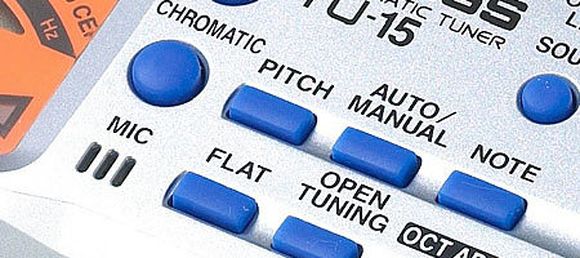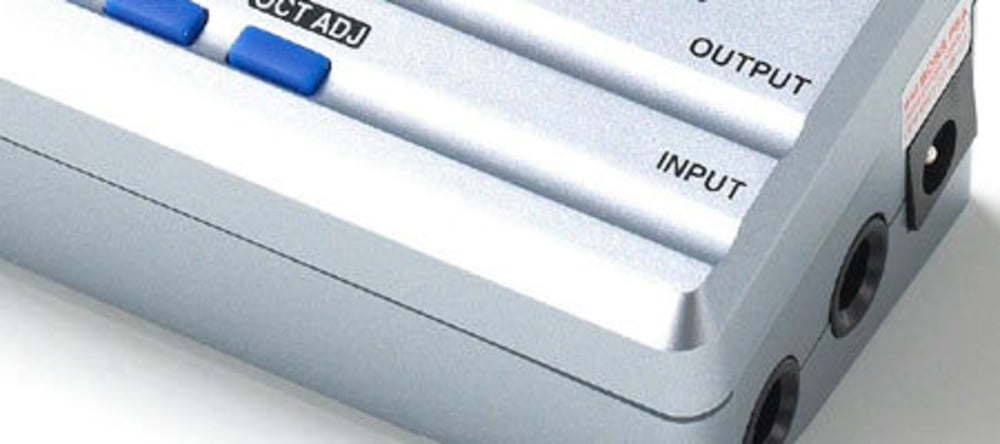3. Basics & Specialised Features
Guitar/Chromatic
Broadly speaking, there are two types of tuner available: instrument-specific tuners - lets call these guitar tuners as the vast majority are designed for guitar or bass and chromatic tuners. A guitar tuner is designed for tuning the instruments strings to their standard pitches, i.e. E A D G B E, whereas a chromatic tuner, as the name implies, covers all twelve notes common to Western music.
While many guitar tuners offer some additional features such as a flat tuning mode (reflecting the common practice of tuning the whole instrument flat by a semitone or more), chromatic tuners are generally much more flexible. Unless you are a guitarist with absolutely no interest in alternate tunings and no need to tune other instruments, a chromatic tuner is probably the best bet for all but the complete beginner. In any case, many chromatic tuners also have a guitar mode.
Manual/Auto
There are two basic tuning modes, and most models use one or the other, although some are switchable. In manual tuning mode, the user must specify the target note before tuning, usually by means of a slider switch. For example, when tuning a guitar, the slider must be set to E, then A, and so on. Auto tuning is generally much simpler: the tuner analyses the incoming pitch, assumes that the target note is whichever note is closest, and then displays the name of this note. This is recalculated as necessary, for example when tuning newly changed strings. Many guitar tuners are switchable between manual and auto, although chromatic tuners tend to use auto mode only, rather than a 12-position slider! If youre just starting out though, manual mode is invaluable as it doesnt require you to have any feel for whether the note youre tuning to is actually the right one.
Flat Tunings
As mentioned previously, flat tuning is common in many heavy rock styles. Some guitar tuners incorporate flat tuning modes (effectively calibration presets see above) so that the player can simply select the desired flat tuning of one or more semitones down, and then proceed as normal.
While a few specialised guitar tuners feature presets for alternate tunings (where the relationship between the strings is different), in general, chromatic tuners are far better suited to this application.
Calibration
Most tuners are set to modern concert pitch by default, where the note A above middle C is tuned to 440Hz. This is the accepted standard for most modern orchestras and nearly all modern instruments. However, some tuners can be calibrated to a higher or lower reference. Some period performance ensembles tune to other pitches (most often A=415Hz, which is nearly a semitone below modern pitch), and also instruments with a fixed, non-standard pitch are sometimes encountered (old pianos/organs, tin whistles, accordions), where there is no choice but to tune the rest of the band to this instrument. The calibration range is usually around 435-445Hz, adjustable in steps of 1Hz, but may be as wide as 380-490Hz with finer adjustment on more specialised models.
Input
Any tuner must have at least one type of input, although many models have two or more.
- Integrated mic: most handheld or pocket tuners have a built-in microphone - the tuner is simply placed close to the instrument or amp. This is obviously the easiest way to tune acoustic instruments such as sax or acoustic guitar, but while it works fine at home, the background noise in live situations can lead to unreliable tuning, or simply cause the tuner to give up.
- External mic input: there are situations in which an external microphone gives better results - this enables the selection of a higher quality microphone appropriate to the instrument, venue or other conditions.
- Instrument/line input: this is usually a jack socket enabling an electronic instrument to be connected directly to the tuner. This has two main advantages - a clean signal with no background noise usually gives a more accurate and stable reading, and this method also enables silent tuning, so the audience doesnt have to hear clanging open strings between songs.
Other Features
- Output/Mute/Bypass: most with an instrument or line input tuners (including all rack and floor tuners) also have one or more outputs. A standard tuner output is automatically muted when the tuning mode is activated - connecting the tuner between the instrument and amp or PA system thereby enables silent tuning at the touch of a button or pedal. A bypass output caters for tone purists - the signal doesnt pass through the tuners circuitry at all, and is therefore not muted when in tuning mode.
- Reference signal: some tuners incorporate a signal generator and integrated speaker or line output for manual tuning. The notes available are usually either those of the standard open guitar strings (guitar tuners), or all 12 chromatic notes (rarely), or A=440Hz only (most common), or A/Bb which is useful for brass instruments and big bands.
- Temperament: a few specialised high-end units feature a variety of historical/non-equal temperaments. (Most modern Western music is based on equal temperament, in which the octave is divided into twelve exactly equal semitones. This is actually a compromise which results in all keys being equally useable and all intervals being equally acceptable to the ear, even though only the octaves are mathematically pure. Historical temperaments divide the octave by various other methods, resulting in some intervals being mathematically pure, while others are much less so which gives different keys different moods.)
- Specialised non-equal tunings include historical temperaments, stretched piano tuning and the Buzz Feiten guitar tuning system - try Googling these for further details if youre interested.



